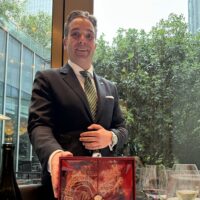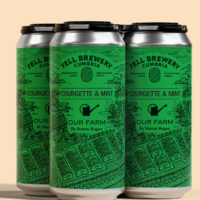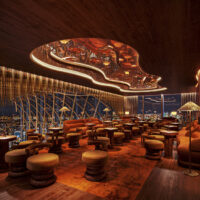Authorities in Corsica have launched an investigation into a producer of “naturally” blue wine after a study published earlier this year found an “unusually high” quantity of an artificial blue dye in the product.

Image: Imajyne
Imajyne, launched in 2017, is made from Vermentino grapes by Domaine Pozzo di Mastri in southern Corsica. According to the brand’s website, the wine’s blue colour is “unprecedented” and completely “natural”, and is achieved through a combination of “the unique soil and know-how”, as well as exposure to “natural minerals, herbs and seaweed”. The website details how grapes are harvested at night and rinsed with seawater before pressing, with the finished bottles then stored in the sea. However, the production process itself remains a closely guarded secret.
Earlier this year, scientists working in the chemistry department at the Paul Sabatier University published the results of a study in which they carried out a chemical analysis on two brands of blue wine – Vindigo and Imajyne. Using high‑resolution mass spectrometry, the study found evidence of food colouring additive Brilliant Blue FCF (E133) in both wines, concluding that the resulting colour was not the result of natural processes, but rather the addition of a dye.
The report noted: “BBfcf levels in Imajyne and Vindigo blue wines are unusually high, and make these wine products far from natural contrary to what the description made by their winemakers suggests.”
It added that as things stand, “it is challenging for winemakers to be able to obtain an appealing blue colour for consumers without the help of a commercial food colouring”.
Eric Bouillard, public prosecutor in the Ajaccio commune of Corsica, has now launched an investigation into Imajyne over “deceptive marketing practices”, following the results of the study.
He told French media that the wine contained “the dye E133”, adding: “The study that has been conducted shows that this product has been made with a dye, which is absolutely forbidden for wine and the producer is not permitted to use the term ‘wine’.”
He added that a former partner in the business was known to have purchased E133 dye back in 2017.
Responding to the findings, Sylvain Milanini, CEO of Pozzo di Mastri, said that the dye was in fact a “mineral salt”.
“Salts are useful for stabilising the colour, which can vary with changes in temperature and time,” he told French media.
“We are treated as cheats because we have a secret process. But it’s normal to keep this information to ourselves – we do not have to disclose how we make our wine.
“We do not use E133; it’s not the same process as curaçao or Vindigo.”
It is claimed that after a warning from authorities, Pozzo di Mastri had changed the name of its product from ‘wine’ to a ‘flavoured cocktail’. Authorities claim this is still misleading owing to the fact that Imajyne does not contain any additional flavourings.
The French department for competition, consumption and fraud control (DGCCRF) noted that colouring additives were forbidden in the production of wine in Europe. However, it stated that while additives were found in the wines, they remained fit for public consumption.
The offence of putting additives into wine carries a maximum sentence of two years in prison and a fine of €375,000, according to the Times. Imajyne currently retails for €35 a bottle.
This is not the first time that the authorities have questioned the claims of blue wine producers. Last year, Véronique Cheynier, director of research at the National Institute of Agricultural Research, aired her doubts on the origin of blue wine brand Vindigo’s blue hue.
The brand claims the colour comes from the natural pigment found in the grape skin (anthocyanin).
Speaking to the Sciences et Avenir, however, Cheynier noted: “I don’t see how anthocyanin derived from red grape pulp can make this wine blue.
“Even if anthocyanin-derived pigments that are blue in colour in an acidic medium have been successfully isolated in the lab, these pigments are only present in tiny quantities in grape skin pulp.
She noted that such pigments are red in an acidic medium, at a low pH, and only turn blue at a pH higher than seven, with most wines having a pH of between 3 and 4.
Read more:
CREATORS OF BLUE WINE FIGHT LABELLING BAN




